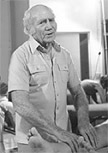About Milton Trager
 Dr. Milton Trager, the creator of The Trager Approach, devoted his life to exploring the effects of gentle movement on the body and the nervous system. "The Trager Approach" is the commonly-used name for Trager® Psychophysical Integration and Mentastics® movement education.
Dr. Milton Trager, the creator of The Trager Approach, devoted his life to exploring the effects of gentle movement on the body and the nervous system. "The Trager Approach" is the commonly-used name for Trager® Psychophysical Integration and Mentastics® movement education.
The principles behind The Trager Approach were discovered serendipitously. In the 1920s, Milton Trager was eighteen and learning to become a boxer. One day he noticed how tired his trainer, Mickey Martin, looked and offered to give him a rub down instead of the other way round. The trainer was astonished at what he felt from young Milton's hands. Surprised and encouraged, Milton went home and worked on his father, who had been suffering from chronic sciatica, which cleared up after two sessions from Milton.
So began an exploration that lasted a lifetime. Over the years Milton Trager would expand, refine, and teach others his discovery of the remarkable effect that mindful, gentle manipulation could have on tight, pain-ridden muscles.
Born in Chicago in 1908 with a congenital spinal deformity, Milton Trager overcame a weak and sickly childhood by patiently practicing until he achieved the athletic, graceful body of a dancer and gymnast. In his late teens his family moved to Miami Beach and he trained to be a boxer - where the now-famous rub down and sciatica cure occurred.
After his discovery, Milton applied his approach with everyone who was open to experiencing it. Thousands of people with painful backs, emphysema, asthma, multiple sclerosis, muscular dystrophy, and polio responded to his touch with degrees of benefit ranging from greater ease to complete cessation of pain and symptoms. In the early years of development, Milton applied his approach to a 19-year-old friend who had polio and was confined to a wheelchair. Milton's approach helped him walk again after four years of paralysis.
Despite his successes in working with people, Milton always denied that he was a healer. His favourite comment was: "I have this thing and it works." He'd add: "We're all healers".
Years of working with people with all kinds of neuro-muscular complaints convinced him that he had something to offer the medical profession. Later in life he said, "My big aim was to teach registered physical therapists my work, because of the results I was getting in comparison with the results they were getting." So, at age 42, he applied to numerous medical schools, but was repeatedly turned down because of his age. He persevered and was finally accepted into the Universidad Autonoma de Guadalajara in Mexico, not knowing a word of Spanish at that time. The university set up a clinic for him to continue his work in psychophysical integration, and six years later in 1955, at age 47, he became an M.D.
Dr. Trager continued to work with clients within his medical practice for the next 20 years. He was frustrated that it had never been possible for him to teach his work, until he was invited to Esalen Institute in Big Sur, California, to give a demonstration. Betty Fuller (who was also instrumental in bringing Moshe Feldenkrais to the United States) was teaching at Esalen at the time and having tremendous problems with her neck. Milton offered to see what he could do for her neck, and after a few minutes her neck was no longer in pain. Betty was instantly "hooked". With Dr. Trager she co-founded The Trager Institute in 1980. Shortly thereafter a certification program was established to train and certify people in his approach.
Dr. Milton Trager passed away in 1997 at age 88. His work continues to evolve as Trager instructors around the world train new practitioners, build on the work of Dr. Trager and share their innovations based on the original Trager principles. There are now thousands of Certified Trager Practitioners (CTPs) in Canada, the United States, Europe, Australia, and Japan.



